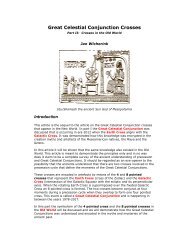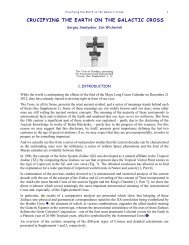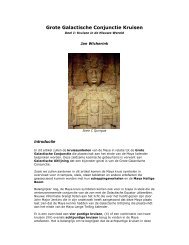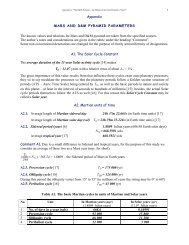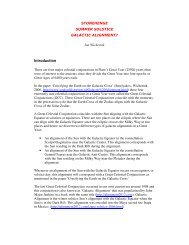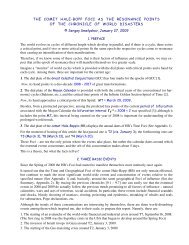THE D&M PYRAMID OF CYDONIA â THE ... - Souls of Distortion
THE D&M PYRAMID OF CYDONIA â THE ... - Souls of Distortion
THE D&M PYRAMID OF CYDONIA â THE ... - Souls of Distortion
Create successful ePaper yourself
Turn your PDF publications into a flip-book with our unique Google optimized e-Paper software.
The D&M Pyramid – the Sibling <strong>of</strong> the Great Pyramid <strong>of</strong> Giza? 7<br />
Thus from this Table we see that the best approximants for the actual lengths <strong>of</strong> the sides <strong>of</strong> the primal<br />
pentagon P are expressed in units <strong>of</strong> those triangles which they represent: the triangle T 1 – in units 1<br />
and<br />
3<br />
2<br />
<strong>of</strong> equilateral triangle, the triangle T 2 – in unit 2 <strong>of</strong> right-angled isosceles , and the triangle<br />
T 3 - in unit ϕ <strong>of</strong> the regular pentagon. What is important, an average error in these approximations is<br />
less than that for the source data error (1); the only exception in the whole Table is side d.<br />
What is also important the DM-ratio<br />
being one order better than<br />
3<br />
2<br />
.<br />
g = e / π gives almost exact approximation for the internal side c<br />
As far as the angles <strong>of</strong> the pentagon P differ significantly from 45°, 60°, and 72°, it is not strange that the<br />
altitudes and areas <strong>of</strong> these triangles differ from the regular ones; nevertheless, they are quite accurately<br />
approximated by the Golden section and <strong>of</strong> DM-ratio.<br />
Amazingly, but the base area S and perimeter P are also expressed in simple relations and with the use <strong>of</strong><br />
the same values – 2 , g and Φ , as well as their parts pertaining to the regular hexagon and pentagon<br />
(engendering the five-fold symmetry); once again, within the tolerance <strong>of</strong> the source data error.<br />
Therefore, alongside with their apparent presence in the floor plan <strong>of</strong> the D&M, the regular square,<br />
pentagon and hexagon are essentially incorporated in the mathematical design <strong>of</strong> the D&M Pyramid<br />
(Table 1) through the constants they define when triangulated: Φ , 2 , and 3 2<br />
or DM-ratio e / π . At<br />
this, use <strong>of</strong> the DM-ratio instead <strong>of</strong><br />
3<br />
2<br />
in the obtained approximants for the side lengths, perimeter and<br />
areas results in a significantly lesser error. For distinctness, call them the primal DM constants.<br />
2.2.2. The D&M floor plan as a cross-section <strong>of</strong> a planet<br />
Draw a circle with the centre at O and radius a (Fig. 2) and liken it to a cross-section <strong>of</strong> a planet. Then, if<br />
a diameter G*K* presents the plane <strong>of</strong> Equator (side view), the central angle ψ presents (as in Fig. A1)<br />
the geographical latitude <strong>of</strong> the point B, and the central angle ξ – the geographical latitude <strong>of</strong> the point E<br />
as In a similar way, if a diameter defined by the straight line H*O is taken for the Equator, the central<br />
angle α / 2 = 30°<br />
gives the geographical latitude <strong>of</strong> the point B, but in this new coordinate system. Here<br />
the segment OG is the altitude to the base BC, and OH – the altitude to the base AB. As these are<br />
altitudes, the respective angles ψ and ξ can easily be obtained: ψ = 40. 4°<br />
, ξ = 19. 6°<br />
.<br />
Now, if we relate the triangle T 1 to Earth, and triangle T 2 (and the symmetric triangle T 2′ ) – to Mars, we<br />
obtain that the altitude OH, as Equator <strong>of</strong> Earth, specifies the latitude L α = 30° (exactly!), and the altitude<br />
OG, as Equator <strong>of</strong> Mars, specifies the latitude L ψ = 40.4°. Besides, one more important latitude is<br />
specified by the vertex E: L t = 19.6°. These are apart from the latitudes L **<br />
= (40.4° + 60°) - 90° =<br />
10.4° (relative to the Mars equator) and L * = 90° - 19.6° = 70.4° (relative to the Earth equator; note that in<br />
this case E presents the North Pole).<br />
But within the accepted accuracy these are namely the latitudes <strong>of</strong> the Great Pyramids and the tetrahedral<br />
constant<br />
Latitude <strong>of</strong> the Great Pyramid <strong>of</strong> Giza:<br />
L GP = 29.9808° ≅ L α ( δ = 0.06 %); (13)<br />
Latitude <strong>of</strong> the D&M Pyramid <strong>of</strong> Cydonia: L DM = 40.65° ≅ L ψ ( δ = 0.6 %); (14)<br />
Latitude <strong>of</strong> the N G (or tetrahedral) constant: L t = 19.47° ≅ L t ( δ = 0.6 %). (15)<br />
To this end it is also interesting to note the following. If b is taken for the unity <strong>of</strong> length (since the<br />
triangle T 2 is likened to Mar’s cross-section), the perimeter makes Φ ( δ = 1%<br />
). For a = 1 the altitude<br />
OG specifies the ratio <strong>of</strong> the Equatorial and Latitudinal lengths <strong>of</strong> 1 angular unit [A3], or geographical to<br />
latitudinal miles: h = λ λ .<br />
b<br />
D<br />
E<br />
3





